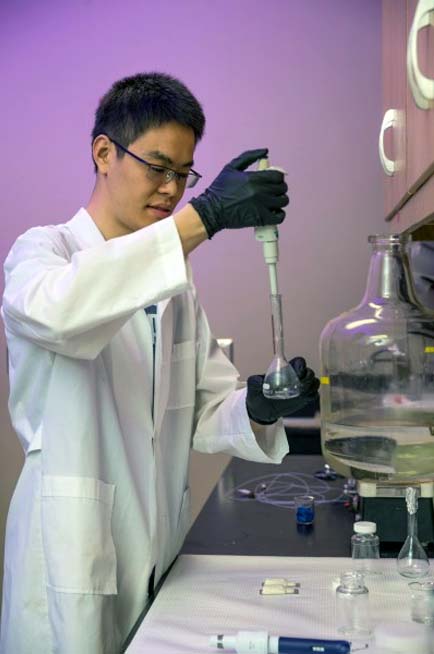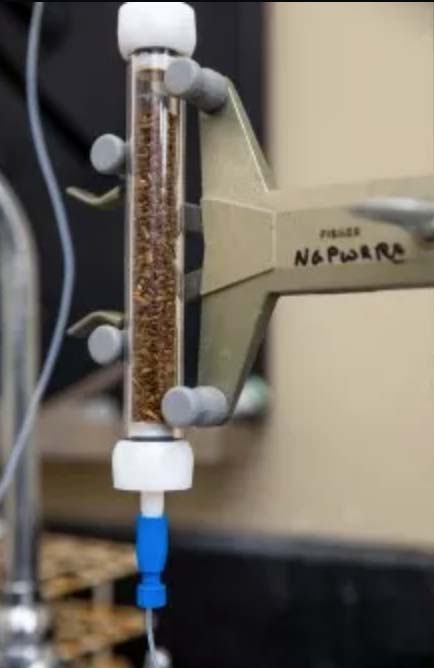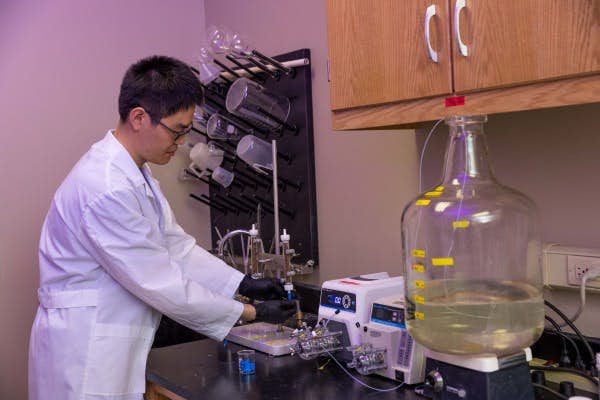Steel Chips Promising New Stormwater Treatment for E. Coli Removal

Dai prepares solutions with varying levels of E. coli to test the effectiveness of steel chips at removing the bacteria. (Credit: SDSU, https://www.newswise.com/articles/view/695035/?sc=swhr&xy=10020912.)
Escherichia coli (E. coli) in stormwater runoff is a perennial problem in South Dakota—and in many other places in the US and around the world. Especially in places where drought makes every drop of rainfall count, it’s crucial to remove harmful bacteria such as E. coli from stormwater. Researchers from the South Dakota State University (SDSU) Department of Civil and Environmental Engineering may have a promising—and cost-efficient—new solution to this problem: steel chips.
After the storm
A good rain can make it seem like everything is fresh and clean—in part because stormwater washes dirt and grime that covers streets down into sewer systems. That includes animal and human waste, and E. coli bacteria.
In fact, according to the South Dakota Department of Environment and Natural Resources, E. coli contamination is one of the principal impairments of water quality in the Big Sioux River. Testing of water quality across various stormwater drainage sites in Brookings, the home of SDSU, revealed post-summer storm E. coli concentrations as high as 2,000 colony forming units (cfu) per 100 milliliters (mL).
“E. coli is one of the major contaminants in rivers, streams, and lakes in SD,” remarks assistant professor Guanghui Hua of SDSU, former advisor to graduate student Peng Dai, who ran the experiments.
“We selected several low cost and readily available materials including zeolite, limestone, steel slag, and steel chips to evaluate their capacities for E. coli removal,” explains Dr. Hua. “The selection of limestone and zeolite were based on literature review, and the selection of steel slag and steel chips were based on our research interests.”

Samples with varying levels of E. coli is run through these steel chips to evaluate their ability to remove the bacteria from the simulated stormwater. (Credit: SDSU, https://www.newswise.com/articles/view/695035/?sc=swhr&xy=10020912.)
A previous graduate student of Dr. Hua’s had tested other mining industry byproducts, along with steel chips. The surfaces of the steel chips carry a positive charge, while E. coli bacteria are negatively charged. This means that electrostatic attraction can draw E. coli to the surface of the steel chips, where it can be absorbed. From there, the steel’s ferric and ferrous ions oxidize the cell membranes of the E. coli cells, killing them.
Carbon steel chips removed 85 to 98 percent of E. coli from stormwater in small column testing.
Smart, cost-efficient solutions
To examine the technology, Dai tested steel chips from 0.5 to 8 millimeters in size in simulated stormwater. To simulate stormwater the team added E. coli to water in varying concentrations. The lowest concentration samples registered at 10 cfu/100 mL, while the highest were at 106 cfu/100 mL.
The team also evaluated how contact time and pH affected the process, testing pH levels of 5, 7, and 9, and contact times between 5 and 20 minutes. The team also controlled the simulated stormwater nutrient levels so that the E. coli could not multiply, but could survive.
The 0.5 to 2 mm chips were most effective, as were longer contact times. In fact, the steel chips removed almost 99 percent of the E. coli after 20 minutes of exposure. The lower pH was ideal for best results, but the team recorded at least 90 percent removal rates for each pH level tested. Practically, this is an excellent result.
“90 percent removal of E. coli from stormwater is an effective treatment efficiency,” comments Dr. Hua. “Such a treatment unit can substantially reduce the levels of E. coli discharged into surface water from the stormwater. This can help rivers and lakes meet the regulatory limit for E. coli.”
The team simulated intermittent stormwater events in addition to performing continuous flow testing. To do this, they circulated the stormwater around the chips at intervals of six hours, interspersed with six hours of dry time for the chips. The chips maintained their high-efficiency removal rate.
The carbon steel chips that worked best are, in essence, waste from industrial processes, making this technology an especially welcome advancement from a cost-efficiency perspective.
“Steel chips are produced from machine shops by cutting, shaping, drilling, and finishing steel products,” details Dr. Hua. “Water filtration using steel chips is a potentially affordable technology.”

South Dakota State University graduate student Peng Dai runs solutions with low to extremely high E. coli levels through columns loaded with steel chips ranging in size from 0.5 to 8 millimeter. (Credit: SDSU, https://www.newswise.com/articles/view/695035/?sc=swhr&xy=10020912.)
“Our previous studies also showed steel chips are effective at removing phosphate from water,” adds Dr. Hua.
This summer, a prototype of an applied version of this technology began testing at a site in south Brookings where residential area stormwater drains into a retention pond. The test involves placing a structure, which resembles a box with an open top, at the pond’s inlet, so the stormwater flows past the steel chips.
“A pilot scale filter was installed at the inlet of a retention pond in south Brookings in May 2018,” comments Dr. Hua. “The filter size is 6 feet in length, 5 feet in width, and 8 inches in height, and was filled with steel chips (70%) and steel slags (30%). The results of the three-month pilot testing showed that the steel chip filter is highly effective at removing E Coli from real stormwater runoff.”
The field-scale testing is still ongoing. Therefore, the team does not have the final numbers for release yet. However, the value of the technology seems clear.
“Stormwater can be a significant source of contamination to natural water bodies, so it is important to develop and implement effective and practical technologies to remove those contaminants from stormwater,” states Dr. Hua. “This technology offers a cost-effective way to remove E. coli from stormwater and to protect our natural water resources.”
Top image: Dai prepares solutions with varying levels of E. coli to test the effectiveness of steel chips at removing the bacteria. (Credit: SDSU, https://www.newswise.com/articles/view/695035/?sc=swhr&xy=10020912.)




0 comments